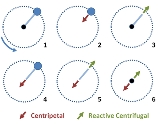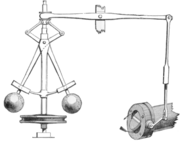
Reactive centrifugal force
Encyclopedia
In classical mechanics
, reactive centrifugal force is the reaction
paired with centripetal force
. A mass undergoing circular motion
constantly accelerates toward the axis of rotation. This centripetal acceleration is caused by a force exerted on the mass by some other object. In accordance with Newton's third law of motion, the mass exerts an equal and opposite force on the object. This reactive force is directed away from the center of rotation, and is exerted by the rotating mass on the object that originates the centripetal acceleration.
by the string tension, causing the centripetal acceleration that corresponds to circular motion. Newton's third law states that if the string exerts a centripetal force on the ball, the ball will exert an equal reaction upon the string, and on the post that anchors the string; this outward force on the post is the reactive centrifugal force.
 Examples of rotating devices in which a reactive centrifugal force can be identified include the centrifugal governor
Examples of rotating devices in which a reactive centrifugal force can be identified include the centrifugal governor
and the centrifugal clutch
.
These devices are commonly analyzed in the frame of reference
of the rotating mechanisms, using the fictitious force
version of the concept of centrifugal force
.
Classical mechanics
In physics, classical mechanics is one of the two major sub-fields of mechanics, which is concerned with the set of physical laws describing the motion of bodies under the action of a system of forces...
, reactive centrifugal force is the reaction
Reaction (physics)
The third of Newton's laws of motion of classical mechanics states that forces always occur in pairs. Every action is accompanied by a reaction of equal magnitude but opposite direction. This principle is commonly known in the Latin language as actio et reactio. The attribution of which of the two...
paired with centripetal force
Centripetal force
Centripetal force is a force that makes a body follow a curved path: it is always directed orthogonal to the velocity of the body, toward the instantaneous center of curvature of the path. The mathematical description was derived in 1659 by Dutch physicist Christiaan Huygens...
. A mass undergoing circular motion
Circular motion
In physics, circular motion is rotation along a circular path or a circular orbit. It can be uniform, that is, with constant angular rate of rotation , or non-uniform, that is, with a changing rate of rotation. The rotation around a fixed axis of a three-dimensional body involves circular motion of...
constantly accelerates toward the axis of rotation. This centripetal acceleration is caused by a force exerted on the mass by some other object. In accordance with Newton's third law of motion, the mass exerts an equal and opposite force on the object. This reactive force is directed away from the center of rotation, and is exerted by the rotating mass on the object that originates the centripetal acceleration.
Paired forces
A ball in uniform circular motion held to its path by a massless string tied to an immovable post is a system in which centripetal force and the centrifugal reaction to it can be easily illustrated. Because the string is assumed to be massless, no centripetal force is needed to maintain the circular motion of the string itself. Newton's second law requires that any body not moving in a straight line is subject to a force, and indeed, the ball is subjected to a centripetal forceCentripetal force
Centripetal force is a force that makes a body follow a curved path: it is always directed orthogonal to the velocity of the body, toward the instantaneous center of curvature of the path. The mathematical description was derived in 1659 by Dutch physicist Christiaan Huygens...
by the string tension, causing the centripetal acceleration that corresponds to circular motion. Newton's third law states that if the string exerts a centripetal force on the ball, the ball will exert an equal reaction upon the string, and on the post that anchors the string; this outward force on the post is the reactive centrifugal force.
Applications

Centrifugal governor
A centrifugal governor is a specific type of governor that controls the speed of an engine by regulating the amount of fuel admitted, so as to maintain a near constant speed whatever the load or fuel supply conditions...
and the centrifugal clutch
Centrifugal clutch
A centrifugal clutch is a clutch that uses centrifugal force to connect two concentric shafts, with the driving shaft nested inside the driven shaft....
.
- A centrifugal governorCentrifugal governorA centrifugal governor is a specific type of governor that controls the speed of an engine by regulating the amount of fuel admitted, so as to maintain a near constant speed whatever the load or fuel supply conditions...
regulates the speed of an engine by using spinning masses set in circular motion by the engine. Should the engine speed increase, the masses swing out to a larger radius and trigger a cut in the throttleThrottleA throttle is the mechanism by which the flow of a fluid is managed by constriction or obstruction. An engine's power can be increased or decreased by the restriction of inlet gases , but usually decreased. The term throttle has come to refer, informally and incorrectly, to any mechanism by which...
. The net force on each spinning mass is the resultant of the downward force of gravity and the tension from the rod or cable supporting the mass. This net force provides the centripetal force necessary to maintain the circular orbit of the mass. The spinning mass exerts a reaction force on the support rod. This reaction force (directed along the rod) has a horizontal component that is the reactive centrifugal force exerted by the circling mass, and a vertical component.
- A centrifugal clutchCentrifugal clutchA centrifugal clutch is a clutch that uses centrifugal force to connect two concentric shafts, with the driving shaft nested inside the driven shaft....
is used in small engine-powered devices such as chain saws, go-karts and model helicopters. It allows the engine to start and idle without driving the device, but automatically and smoothly engages the drive as the engine speed rises. A spring is used to constrain the spinning clutch shoes. At low speeds, the spring provides the centripetal force to the shoes, which move to larger radius as the speed increases and the spring stretches under tension. At higher speeds, when the shoes can't move any further out to increase the spring tension, due to the outer drum, the drum provides some of the centripetal force that keeps the shoes moving in a circular path. The force of tension applied to the spring, and the outward force applied to the drum by the spinning shoes are the corresponding two reactive centrifugal force. The mutual force between the drum and the shoes provides the friction needed to engage the output drive shaft that is connected to the drum.
These devices are commonly analyzed in the frame of reference
Frame of reference
A frame of reference in physics, may refer to a coordinate system or set of axes within which to measure the position, orientation, and other properties of objects in it, or it may refer to an observational reference frame tied to the state of motion of an observer.It may also refer to both an...
of the rotating mechanisms, using the fictitious force
Fictitious force
A fictitious force, also called a pseudo force, d'Alembert force or inertial force, is an apparent force that acts on all masses in a non-inertial frame of reference, such as a rotating reference frame....
version of the concept of centrifugal force
Centrifugal force
Centrifugal force can generally be any force directed outward relative to some origin. More particularly, in classical mechanics, the centrifugal force is an outward force which arises when describing the motion of objects in a rotating reference frame...
.
Relation to inertial centrifugal force
Reactive centrifugal force, being one-half of the reaction pair together with centripetal force, is a concept which applies in any reference frame. This distinguishes it from the inertial or fictitious centrifugal force, which appears only in rotating frames.| Reactive centrifugal force | Inertial centrifugal force | |
|---|---|---|
| Reference frame |
Any | Only rotating frames |
| Exerted by |
Bodies moving in curved paths |
Acts as if emanating from the rotation axis, but has no real source Fictitious force A fictitious force, also called a pseudo force, d'Alembert force or inertial force, is an apparent force that acts on all masses in a non-inertial frame of reference, such as a rotating reference frame.... |
| Exerted upon |
The object(s) causing the curved motion, not upon the body in curved motion |
All bodies, moving or not; if moving, coriolis force is present as well |
| Direction | Opposite to the centripetal forcecausing curved path |
Away from rotation axis, regardless of path of body |
| Kinetic Kinetics (physics) In physics and engineering, kinetics is a term for the branch of classical mechanics that is concerned with the relationship between the motion of bodies and its causes, namely forces and torques... analysis |
Reaction to the centripetal force |
Included as a fictitious force Fictitious force A fictitious force, also called a pseudo force, d'Alembert force or inertial force, is an apparent force that acts on all masses in a non-inertial frame of reference, such as a rotating reference frame.... in Newton's second law according to D'Alembert's principle D'Alembert's principle D'Alembert's principle, also known as the Lagrange–d'Alembert principle, is a statement of the fundamental classical laws of motion. It is named after its discoverer, the French physicist and mathematician Jean le Rond d'Alembert... |

